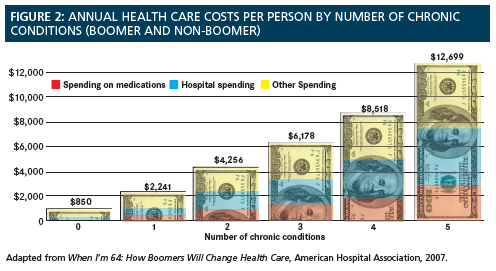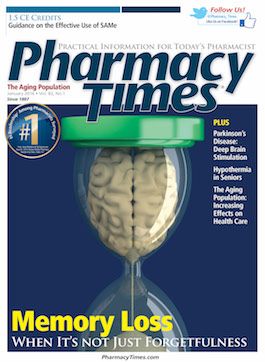Publication
Article
Pharmacy Times
The Aging Population: The Increasing Effects on Health Care
Author(s):
With an aging population that continues to grow, our health care system will be changed forever.
With an aging population that continues to grow, our health care system will be changed forever. Are we ready for it?

According to the Global Health and Aging report presented by the World Health Organization (WHO), “The number of people aged 65 or older is projected to grow from an estimated 524 million in 2010 to nearly 1.5 billion in 2050, with most of the increase in developing countries.” In addition, by 2050, the number of people 65 years or older is expected to significantly outnumber children younger than 5 years of age (Figure 11).
WHO attributes the elderly population’s rapid size increase to a change in the leading cause of death—from infections to chronic noncommunicable diseases—which increased life expectancy.1 These chronic conditions may include hypertension, high cholesterol, arthritis, diabetes, heart disease, cancer, dementia, and congestive heart failure. Heart disease, stroke, and cancer have been the leading chronic conditions that have had the greatest impact on the aging population, especially in high-income countries.1 In addition, the incidences of obesity and falls are increasing.1-3
This leads to the question: what are the implications of the aging population on health care? We have all heard the term “baby boomer.” According to the Office of Disease Prevention and Health Promotion, the first Baby Boomers (those born between 1946 and 1964) turned 65 in 2011.2 By 2030, it is projected that more than 60% of this generation will be managing more than 1 chronic condition. Managing these chronic conditions, along with a patient’s level of disability, will increase the financial demands on our health care system.3 The cost increases with the number of chronic conditions being treated, taking into account the expected twice as many hospital admissions and physician visits for Baby Boomers by 20303 (Figure 23).

According to the WHO report, some believe that as life expectancy increases, the prevalence of disability will decrease because the progress we make in medicine will slow disease progression from chronic disease to disability. As a result, there will be a decrease in severe disability, but there will be increases in milder chronic diseases.1 Other researchers, however, believe that as life expectancy increases, the prevalence of disability will increase.
There are certain health conditions that are expected to be a challenge to our health care system with the increasing aging population. These conditions include cancer, dementia, increase in the number of falls, obesity, and diabetes.
Cancer
Due to the increasing aging population, the number of cancer cases is expected to increase to 17 million by 2020 and 27 million by 2030.1
Dementia
The burden of dementia is expected to increase with the increasing aging population, as well. Alzheimer’s Disease International projects there will be 115 million individuals living with Alzheimer’s disease/dementia in the world by 2050. The organization also projects a significant proportion of the 115 million will be in less developed countries.1
Increase in Falls
With falls being one of the most common causes of injury in the older population, this is expected to be a challenge to our health care system. This is attributed to the fact that Baby Boomers are living longer, remaining active, and possibly on medications that could lead to falls.3
According to a report released by the American Hospital Association (AHA), “More than one-third of adults 65 or older fall each year. Of those who fall, 20% to 30% suffer moderate to severe injuries (such as hip fractures) that decrease mobility and independence. Almost 350,000 hip fractures occurred in 2000, a figure that is expected to double by the year 2050.”3
Obesity
The number of people who are considered obese will continue to increase and have a negative impact on our health care system. Not only is obesity a risk factor for many health conditions, but it is very costly: patients who are obese cost the Medicare program approximately 34% more compared with patients of normal weight.3
Diabetes
According to another report released by the AHA, the number of “Americans with diabetes is expected to rise from 30 million today to 46 million by 2030, when 1 of every 4 Boomers, 14 million, will be living with this chronic disease.”3
Challenges
Expected challenges to the health care system include the following3-5:
- Resource needs will continue to increase across all health care settings
- The incidence of obesity will continue to increase
- A shortage of health care professionals is expected
- The diversity of caregivers lags behind the growing diversity of patients
- Care has been focused on a single disease versus addressing comorbidity
- The sustainability and structure of federal programs in relation to the increasing aging population are a concern
- Changes in family structure may lead to fewer family caregivers
- Adapting and adjusting to the Affordable Care Act pose challenges
To address the increasing aging population, the health care system must take on the challenges listed above. Our health care system also needs to prepare for new technology (especially because of the higher cost) by increasing training of health care workers and examining how technology will impact hospital infrastructure.3
The health care system will need to prepare for the increasing incidences of chronic conditions within the aging population, as well as develop strategies to prevent falls. An important challenge is implementation of new approaches in health care delivery to address the changing health status of this aging population. With chronic conditions on the rise in this population, their health care becomes more complex. Focusing on a single disease rather than comorbidity can result in insufficient focus on other present medical conditions.4
Instead, the health care system must prepare for implementing a multidisciplinary approach to ensure patients are receiving better case management. There also needs to be a focus on providing preventive care versus reactive care. Strategies may include a more comprehensive care plan before discharge, a system to help identify patients who require follow-up, and implementation of a program to help monitor patients.3
Dr. Garza received her doctor of pharmacy degree from the University of Texas at Austin. She is currently working as the director of the Life Sciences Library at RxWiki, where she continues to build her practice on the fundamental belief that providing patients with medication information and medical knowledge contributes significantly to the quality of care they receive and improves quality of life and health outcomes. Her work focuses on educating patients and providing them with the resources needed to navigate the overwhelming and complex health system. Before RxWiki, she was director of pharmacy for a Central Texas Department of Aging and Disability Services facility.
References
- Suzman R, Beard J. Global health and aging: preface. National Institute on Aging website. www.nia.nih.gov/research/publication/global-health-and-aging/preface. Published October 2011. Updated January 22, 2015. Accessed August 1, 2015.
- Older adults. HealthyPeople.gov website. www.healthypeople.gov/2020/topics-objectives/topic/older-adults. Accessed August 1, 2015.
- American Hospital Association. When I'm 64: How Boomers Will Change Health Care. Chicago, IL; 2007.
- Fried LP, Ferrucci, Darer J, Williamson JD, Anderson G. Untangling the concepts of disability, frailty, and comorbidity: implications for improved targeting and care. J Gerontol A Biol Sci Med Sci. 2004;59(3): 255-263.
- National Academy of Sciences. Population aging will have long-term implications for economy. ScienceDaily website. www.sciencedaily.com/releases/2012/09/120925143920.htm. Published September 25, 2012. Accessed August 1, 2015.







